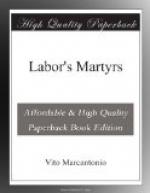During the years 1919 and 1920 two phenomena made their appearance in the state of Massachusetts. One was national, the other local. The first was Mitchell Palmer’s red delirium which caused him to hunt radicals with the same zeal but much more frenzy than the old Massachusetts witch hunters in every corner of the land. The second was a wave of payroll robberies obviously executed by a skilled and experienced gang of bandits.
In April, 1920, both these currents crossed the paths of Sacco and Vanzetti. Their friend Andrea Salsedo was arrested by Palmer’s “heroes,” tortured, held incommunicado for 11 weeks and thrown from the eleventh story of the Department of Justice office in New York City to his death. This happened on May 4, 1920. Early in April the Slater and Merrill Shoe Factory paymaster was murdered in Bridgewater, Massachusetts, and some $15,000 carried off. On May 5, Sacco and Vanzetti were arrested in South Braintree, Massachusetts, and held on suspicion of being the guilty bandits. After he nabbed them, Chief of Police Stewart discovered, with the aid of Department of Justice agents, that he had two dangerous radicals marked for “watching” in Department files in Washington.
What happened after that, though it lasted seven long and torturous years, is fairly familiar to the American people. It ended ten years ago in the electric chair at Charlestown Jail in Massachusetts. The finest minds in the world, the greatest masses of workers and their friends, made their protest known to the American government, through its embassies, before its government buildings, in the streets and roadways of America.
But Judge Webster Thayer, who bragged, “Did you see what I did to those anarchistic bastards,” disregarded all the evidence proving their innocence, poisoned the minds of the already hatred-ridden jury against them, with speeches about the soldier boys in France, the flag, “consciousness of guilt,” the perfidy of “foreigners.” The witnesses for the defense proved the innocence of Sacco and Vanzetti beyond the shadow of a doubt. Italian housewives told of buying eels from Vanzetti on the day of both crimes with which he was charged (another payroll robbery committed on Christmas eve, 1919, was thrown in for good measure against him, to secure that conviction first and bring him to trial for murder as a convicted payroll robber). Sacco had an official from the Italian Consulate in Boston to testify for him. He had been in Boston on the day of the Bridgewater crime enquiring about a passport to Italy for himself, his wife and child. The official couldn’t forget him, because instead of a passport photo he brought a big framed portrait of his whole family with him!
Ballistic testimony from an expert who was a state witness was brought to show that the fatal bullet was not Sacco’s, but to no avail. New trials were denied. The State Supreme Court upheld the murder verdict. The governor upheld it. He appointed a special commission of professors headed by President Lowell of Harvard, and they upheld it. Four justices of the United States Supreme Court were contacted for a stay of execution. All refused.




